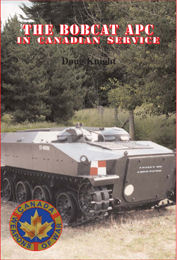 The Bobcat APC in Canadian Service
The Bobcat APC in Canadian Serviceby Doug Knight .
Canada's Weapons of War Series, WOW019
A5 size softback, 24 pages
ISBN: 978-1-894581-47-9
Service Publications,
Canada
www.servicepub.com
Review by Peter Brown
The title of this book is a little misleading as the Bobcat never entered service with the Canadians or anyone else.
Intended to provide the Canadian army with an armoured personnel carrier, it was developed during the 1950s and early 1960s. Canada had pioneered the use of full-tracked APCs during WW2, first with unarmed Priest self-propelled guns and later turretless Ram tanks, both known as Kangaroo. They were improvised using what was available at the time and both had drawbacks. It was proposed to create a new and better vehicle starting from a clean sheet.
Initial ideas were for a modern version of the wartime Universal Carrier which was then still in service. The requirement soon evolved to add protection from above and it was then decided that the basic troop carrier vehicle would be the basis of a family of vehicles. Weapon carriers, command and ambulance versions would use the APC with additional items as needed, with a dedicated load carrier and self-propelled 105mm howitzer having different bodies using the basic chassis, engine and mechanical components.
While the idea was good and it was even hoped that the vehicle could be sold abroad, the project was dogged by problems. Changing requirements meant that the design had to be altered while the company chosen to develop the vehicle went through several reorganisations and changes of location which all slowed development. Several prototypes were built and tested which brought various problems to light. Making the vehicle air portable meant that it had to be small and this resulted in it being cramped.
As the main contractor was more used to designing aircraft, their lack of experience with ground vehicles may have been one reason why the trials vehicles were too noisy for comfortable use. Some of the ideas and materials were then at the forefront of technology which caused technical problems and would have caused more had the vehicle gone into service.
In the end the Bobcat project ran out of time. As the Canadian army needed an APC in service, the quickest and cheapest option was to adopt an existing design already in service. The American M113 was chosen and Bobcat development ended without production or service. Despite its lack of use the Bobcat makes interesting reading, not least because it shows what can go wrong with a project.
Its story is well told and fully illustrated with twenty two black and white photos and a four-view 1/35th scale plan. These will allow anyone interested to produce a model of the vehicle, given its history a kit is unlikely but it would make an unusual scratchbuilding project.
Thanks to Clive Law at Service Publications for the review book.
